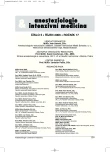Extreme hypoxic lactaemia in patients on critical care – prognosis, therapeutic options and their limitations
Authors:
M. Kolář; A. Součková; Z. Stach; J. Valenta
Authors‘ workplace:
Klinika anesteziologie, resuscitace a intenzivní medicíny, 1. LF UK a VFN, Praha
Published in:
Anest. intenziv. Med., 17, 2006, č. 5, s. 266-270
Category:
Intensive Care Medicine - Original Paper
Overview
Objective:
The determination of prognostic factors and evaluation of therapeutic options in patients with tissue (cellular) hypoxia presented as high lactate levels.
Type of study:
Retrospective study.
Setting:
Department of Anaesthesiology and Intensive Care Medicine, teaching hospital.
Material and Methods:
Inclusion criteria were serum lactate > 8 mmol/L at any point during the first 24 hours after admission and the presence of tissue hypoxia (PaO₂ < 8.8 kPa and/or SpO₂ < 90%, PvO₂ < 4.7 kPa) in association with conditions inevitably associated with hypoxia (circulatory arrest, cardiopulmonary resuscitation, circulatory failure). APACHE II score system was used for assessment of the severity of the critical condition. The relationship between the monitored parameters, markers and survival rate were evaluated. The absolute positive and negative relationship between the monitored parameters and survival was estimated.
Results:
The group included 11 patients. Three of them survived, two without a disability. The unfavorable prognostic factors related to the highest absolute mortality rate included: MOF syndrome affecting more than 4 organ systems, liver failure with persistent elevated lactate above 8.0 mmol/L during the first 24 hours after admission, and the presence of other symptoms of tissue hypoxia (PaO₂ < 8.8 kPa, PvO₂ < 4.7 kPa, pH < 7.1). An aggressive treatment restoring physiological parameters of oxygen metabolism (primary circulation therapy) may result in serum lactate level restoration and tissue hypoxia elimination within 24 hours. This is strongly associated with a significantly higher survival rate without a future disability especially in patients recovering from septic shock. The extent of the therapeutic approach is limited in cases of untreatable vital organ system failure.
Key words:
lactate – hypoxemia – critically ill patient
Labels
Anaesthesiology, Resuscitation and Inten Intensive Care MedicineArticle was published in
Anaesthesiology and Intensive Care Medicine

2006 Issue 5
Most read in this issue
- Extreme hypoxic lactaemia in patients on critical care – prognosis, therapeutic options and their limitations
- Limitation of therapy in patients on ICU – a one-day national study
- Fuzzy logic in anaesthesiology as a way of thinking and a tool for practical applications
- Administration of COX-2 inhibitors modifies the course of postoperative delirium in cardiac surgery patients
